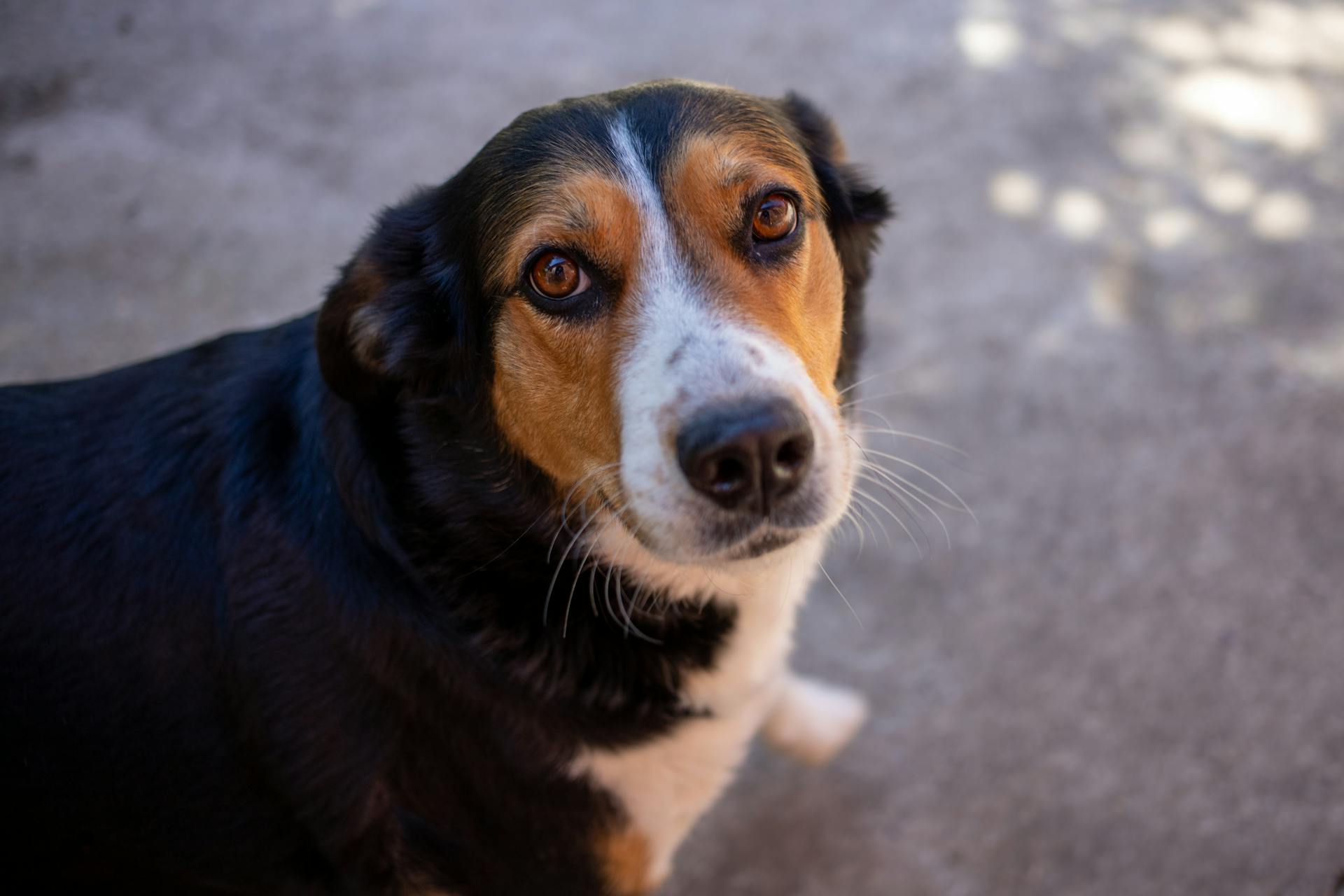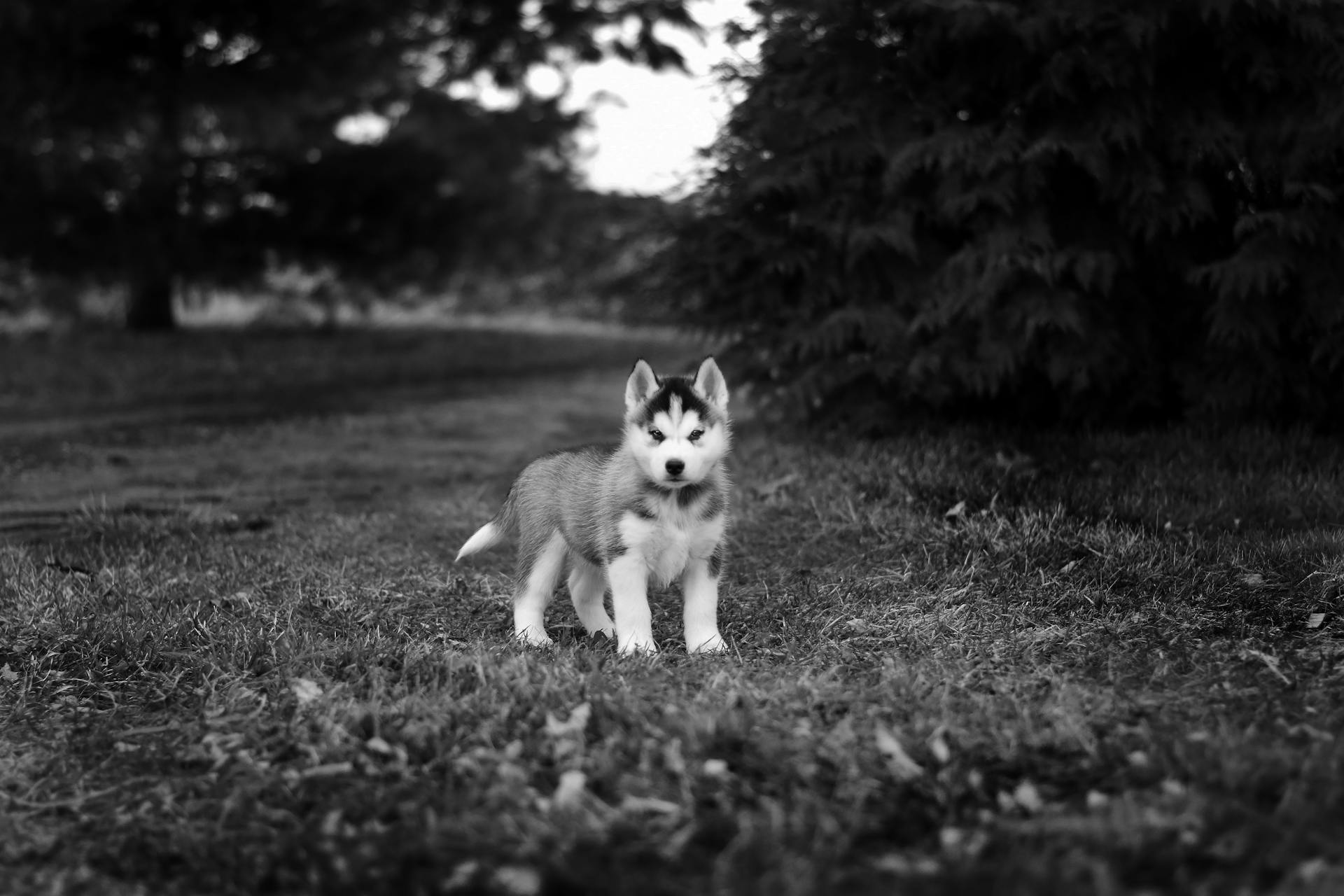
Kurī the Ancient Māori Dog was a remarkable breed that played a significant role in the lives of New Zealand's indigenous people, the Māori.
Kurī were highly valued for their hunting skills, and their ability to track and catch prey made them an essential part of Māori daily life.
They were also skilled at navigating the rugged terrain of New Zealand, making them well-suited to the country's diverse landscape.
These intelligent dogs were capable of adapting to various environments, from the forests to the coastlines.
Additional reading: Huntaway Breed
History and Origins
The Kurī Māori has a rich history that dates back to Māui and Irawaru, who is said to be the origin of the Dog in Māori oral tradition.
According to Rereata Mākiha, the Kurī Māori were highly valued by the Māori people and were kept as pets, with some even being fed better than children.
Their importance can be seen in the fact that their bones, teeth, and fur were used to make important tools.
The Kurī Māori played multiple roles, including being companions and helping with hunting birds.
Emma Ash, a curator at the Auckland Museum, notes that Patricia Pillay's research is groundbreaking in looking into the role of kurī and their diet.
Characteristics and Care
Kurī had a remarkably low-sugar diet and ate soft meals, which contributed to their excellent oral health.
Their teeth showed no cavities or plaque, and only a few were cracked or damaged seriously.
In fact, kurī were so well cared for that no signs of starvation or sickness were found in the archaeological sites studied.
It's clear that kurī were highly valued by the Māori people, not just for their economic value or job as hunters, but also for their hides and fur, which were made into important ceremonial items like cloaks for chiefs.
Description
The Kurī had a unique appearance, with bushy tails and short legs.
Their powerful shoulders and sturdy build made them well-suited for their native New Zealand environment.
Their coat colour varied, ranging from yellowish brown to black, white, or spotted.
Like other Polynesian dog breeds, the Kurī howled instead of barking, a distinctive characteristic that's still remembered today.
Well Cared For

Kurī were well cared for in the past, with no signs of starvation or sickness found in archaeological sites. This suggests that they had a low-sugar diet and ate soft meals.
Their bones and teeth are often found in early coastal settlements, indicating their importance in hunting, especially for moa. Kurī were also highly valued for their hides and fur, which were made into cloaks for chiefs.
Kurī were not pets in the modern sense, but they were valuable in ways other than their economic value or job as hunters. They were even given names and whakapapa, showing a more complex relationship with humans.
In Aotearoa, dogs are mentioned in traditional oral histories and found in their own formal burials, suggesting a deeper connection with their human caregivers. This highlights the importance of understanding the historical context of human-dog relationships.
For more insights, see: Bernese Mountain Dog Next to Human
Relationship with Māori
The Kurī Māori has a rich history in Māori culture.
According to Rereata Mākiha, the Kurī Māori can be traced back to Māui and Irawaru, who was the husband of Hinauri, the sister of Māui.
Māori have always known the special place Kurī Māori had. They were kept as pets and fed better than children.
Emma Ash notes that Kurī were also important for hunting birds and their bones, teeth, and fur were used to make important tools.
Māori Origins
The Māori people have a rich history and culture, and it's fascinating to learn about their origins. In the Māori oral tradition, the Kurī Māori can be traced back to Māui and Irawaru, who was the husband of Hinauri, the sister of Māui.
The Kurī Māori were highly valued in Māori society, and were often kept as pets. According to Rereata Mākiha, they were even fed better than children.
Māori have always known the special place Kurī Māori had in their culture, and their importance extended beyond being companions. Emma Ash, a curator at the Auckland Museum, notes that their bones, teeth, and fur were used to make important tools.
The Kurī Māori played multiple roles in Māori society, including hunting birds. Their diet is also an area of interest, with Patricia Pillay's research being the first to look into this aspect of their lives.
A Dog's Life: Māori Fate
In Māori oral tradition, the Kurī Māori can be traced back to Māui and Irawaru, who was the husband of Hinauri, the sister of Māui.
The Kurī Māori were highly valued by the Māori, with Rereata Mākiha remembering stories that they were fed better than children.
Kurī were kept as pets, and their bones, teeth, and fur were used to make important tools.
Emma Ash notes that the Kurī played multiple roles, including companions and hunting birds.
Their diet was likely a crucial aspect of their role, but Patricia Pillay's research is the first to really look into this.
Use and Significance
Kurī were a source of food for Māori, and considered a delicacy.
British explorer James Cook sampled kurī on his 1769 voyage and declared that it was almost as tasty as lamb.
Their meat was used to make a variety of dishes, but it's worth noting that kurī were highly valued for their culinary worth.
Kurī were also used to hunt birds, showcasing their versatility and importance in Māori culture.
Māori used their skins and fur to make dog-skin cloaks, which were likely worn for warmth and as a status symbol.
Frequently Asked Questions
What did the kurī eat?
The kurī's diet was varied and not limited to fish, with some individuals consuming more protein than others. Their diet likely reflected their social status and environment.
Sources
- https://en.wikipedia.org/wiki/Kur%C4%AB
- https://www.auckland.ac.nz/en/news/2022/04/05/a-dog-s-life-the-fate-of-maori-kuri.html
- https://www.teaonews.co.nz/2022/04/08/extinct-maori-kuri-the-focus-of-auckland-university-research/
- https://www.rnz.co.nz/news/te-manu-korihi/286397/secrets-of-ancestors'-best-friend-revealed
- https://www.scoop.co.nz/stories/ED2204/S00006/a-dog-s-life-the-fate-of-maori-kuri.htm
Featured Images: pexels.com

